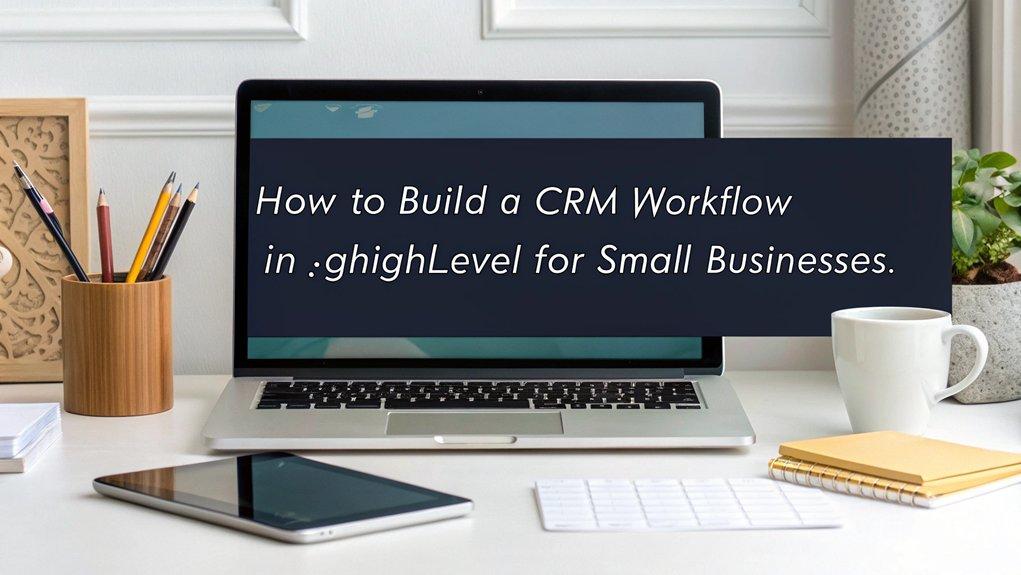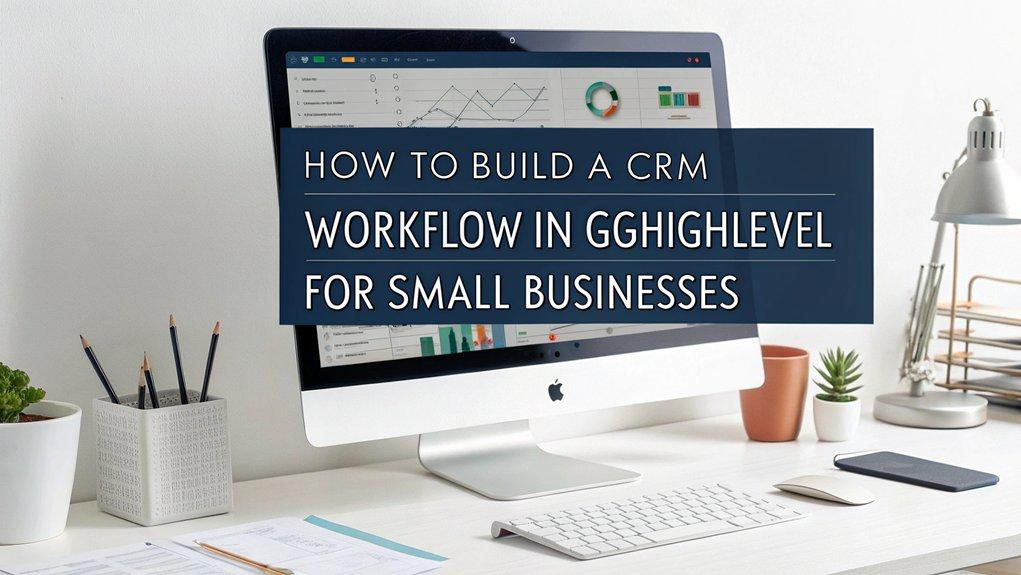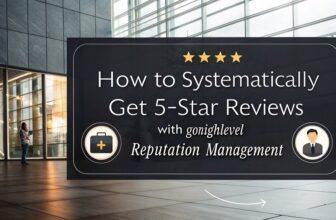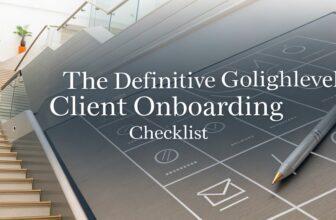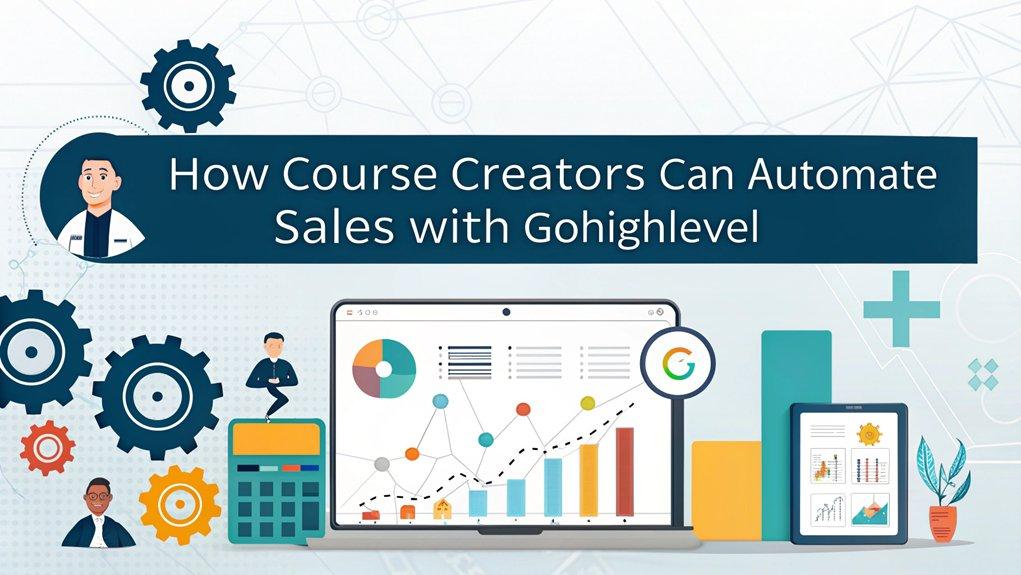To build a CRM workflow in GoHighLevel for your small business, start by navigating the Automation section on your dashboard. Define specific triggers such as form submissions to initiate workflows, and customize actions, like automated emails, for enhanced engagement. Utilize conditional logic with IF/Else conditions to tailor responses based on customer interactions. Finally, ensure effective follow-ups with automated emails and SMS reminders. Master these steps, and you’ll be prepared for more advanced optimizations.
Key Facts Summarized
- Access the GoHighLevel dashboard and locate the “Automation” tab to start creating your CRM workflow.
- Define triggers based on specific events like form submissions or appointment bookings for effective workflow initiation.
- Customize actions using features like email sequences and SMS reminders to enhance customer engagement and satisfaction.
- Implement conditional logic with IF/Else conditions to tailor workflows based on customer interactions and preferences.
- Test workflows with a new contact to identify and resolve any potential issues before full implementation.
Navigating the Automation Section in GoHighLevel
When you’re ready to enhance your CRM capabilities in GoHighLevel, diving into the Automation section is a strategic move. Access the GoHighLevel dashboard and locate the “Automation” tab for a comprehensive overview.
Here, you can create and manage workflows, using triggers like form submissions or appointments to initiate actions. The section offers customization through advanced features such as IF/Else conditions, allowing you to tailor workflows to specific criteria and improve operational efficiency.
By setting precise triggers and actions, you ensure seamless CRM processes. It’s crucial to test workflows with a “fresh” contact, which provides an accurate execution and identifies potential issues.
This proactive approach optimizes your automation strategy and ensures your business runs smoothly.
Defining Triggers for Your CRM Workflow
Defining triggers for your CRM workflow in GoHighLevel is a strategic step that sets the stage for effective automation.
Triggers initiate workflows based on specific events like form submissions or appointment bookings, enabling automated responses tailored to user actions. You can customize triggers under various conditions to ensure workflows are precise and relevant, enhancing lead management.
By setting up multiple triggers within a single workflow, you can accommodate diverse customer interactions, allowing for complex automation scenarios. Properly established triggers determine when contacts are added for follow-up actions, crucial for maintaining engagement.
Using trigger filters refines workflow activation, boosting efficiency and targeting. This methodical approach in GoHighLevel ensures your automated processes are both effective and responsive to customer needs. Additionally, understanding audience needs is essential for crafting triggers that resonate with user behaviors and preferences.
Customizing Workflow Actions for Enhanced Engagement
To elevate customer engagement within GoHighLevel, customizing workflow actions is imperative. By doing so, you can automate personalized email sequences to boost engagement rates by aligning content with customer preferences.
Consider these strategies:
- Implement IF/Else conditions to ensure responses are tailored according to each customer’s interactions.
- Integrate automated SMS reminders to deliver timely notifications, enhancing customer engagement and satisfaction.
- Use performance reports to analyze metrics like open rates and conversions, allowing for data-driven adjustments that refine campaign effectiveness.
- Automate review requests to collect feedback efficiently, improving your online reputation with timely prompts.
- Focus on creating personalized experiences within workflows to foster deeper connections with your audience.
Additionally, leveraging audience research can ensure that your workflow actions resonate with your target audience’s needs and preferences.
These tactics will significantly enhance your customer engagement strategy.
Utilizing Conditional Logic for Tailored Processes
Customizing workflow actions sets the foundation for crafting effective customer engagement strategies, leading to the strategic use of conditional logic for tailored processes.
In GoHighLevel, conditional logic allows you to create automated workflows that branch based on specific criteria. This empowers your CRM for small businesses to send personalized emails and tailored responses, crucial for improving customer engagement.
By utilizing IF/Else conditions in the workflow builder, you can customize actions like sending different follow-up emails depending on lead engagement levels or appointment types. This enhances automation efficiency and ensures contacts receive communications relevant to their unique interactions.
Implementing conditional logic not only streamlines operational processes but also improves workflow effectiveness, reducing irrelevant messages and optimizing lead engagement throughout the sales funnel. Additionally, understanding audience profiling is essential for creating targeted workflows that resonate with your customer base.
Ensuring Effective Follow-Ups With Workflow Automation
While maximizing efficiency is key, ensuring your follow-up processes are effective through workflow automation in GoHighLevel is crucial for sustained customer engagement.
By implementing marketing automation, you can send follow-up emails and SMS reminders automatically, enhancing lead generation and fostering personalized responses. Here’s how to strategically leverage this:
- Set triggers for events like form submissions or purchases to streamline communication.
- Automate follow-up emails to maintain a consistent touchpoint in the sales funnel.
- Utilize GoHighLevel’s reporting features to monitor engagement metrics, optimizing strategies.
- Focus on conversion rates by delivering timely, relevant interactions that nurture leads.
- Reduce manual tasks, allowing small business owners to prioritize critical operations.
- Incorporate analyzing results to refine your workflow and ensure it aligns with your audience’s needs.
With workflow automation, you ensure effective follow-ups that drive conversions and enhance engagement.
Frequently Asked Questions
How to Build a Workflow in Gohighlevel?
To build a workflow in GoHighLevel, start by selecting a trigger like form submissions.
Use trigger filters to ensure relevant contacts enter your workflow.
Define actions like sending emails or SMS reminders.
For complexity, add IF/Else conditions for branching paths, tailoring communication based on criteria.
Regularly monitor and tweak your workflow using performance metrics to optimize your automation strategy for improved engagement and results.
How Do I Create a CRM Workflow?
Creating a CRM workflow is like crafting a well-oiled machine. First, choose a trigger, such as form submissions, to initiate your process.
Use trigger filters to ensure precision in who enters the workflow. Define actions—automate emails or SMS for seamless follow-ups.
Use IF/Else conditions for strategic branching based on behavior. Regularly analyze workflow performance, and tweak triggers and actions to maximize engagement and conversions, maintaining peak efficiency.
Is Gohighlevel a CRM Software?
Yes, GoHighLevel is indeed a CRM software.
It strategically integrates tools like sales funnel management, email, and SMS marketing into a single, user-friendly interface. You can streamline and automate workflows to enhance operational efficiency.
With its unlimited sales funnels and customizable options, it empowers you to engage customers effectively.
Additionally, the reporting and analytics features enable you to track sales conversations and manage leads, facilitating informed decision-making.
How Do Small Businesses Use CRM?
Investigate the theory that small businesses can’t thrive without effective CRM systems.
You’ll find they streamline customer interactions, automate tasks, and centralize data. You can track sales, manage leads, and ensure no follow-up is missed.
CRMs automate emails, SMS, and provide visual sales pipelines and reports. By reducing reliance on spreadsheets, they help you focus on strategic growth, ultimately meeting rising customer expectations for personalized service and faster responses.
Conclusion
By mastering GoHighLevel’s CRM workflows, you can revolutionize your small business operations. Imagine a local bakery automating customer follow-ups after each purchase; by defining triggers and customizing actions, they boost repeat sales and customer loyalty. Utilize conditional logic to tailor processes, ensuring each interaction feels personalized. With strategic automation, you’re not just saving time—you’re building stronger customer relationships and driving growth. Embrace these tools, and watch your business thrive.

